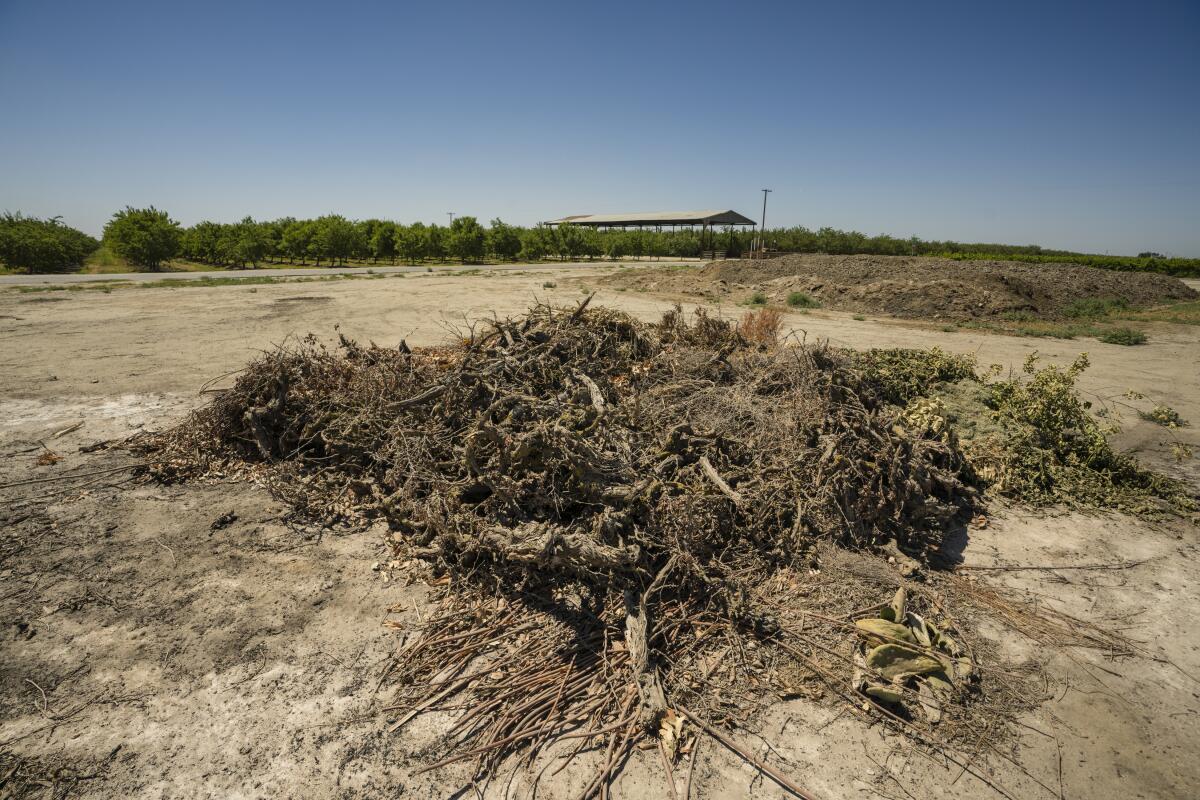
Starting this week, San Joaquin Valley farmers are banned from burning agricultural waste in the field, a legislative mandate aimed at improving air quality that has been decades in the making.
The near-complete prohibition on mass burns of agricultural prunings and field crops, as well as orchards and vineyards removed from production, marks a major shift for the San Joaquin Valley, an agricultural powerhouse that is home to some of the worst ozone and particulate pollution in the nation. The state has pushed for years to curtail open burns, citing the region’s high rates of respiratory illness and other health concerns associated with poor air quality.
But the regulation has met with stiff opposition among growers and local officials who contend costlier alternatives for disposing of waste impose a burden on California farmers and put them at a competitive disadvantage.
The burning ban stems from Senate Bill 705, legislation signed in 2003 that aimed to phase out agricultural burning in the San Joaquin Valley by 2010. To appease opponents, the bill contained a provision that gave the San Joaquin Valley Air Pollution Control District leeway to postpone the deadline if it determined there was “no economically feasible alternative” for eliminating the waste. The district repeatedly did so, asking for extensions, year after year, that were granted by the state Air Resources Board.

In 2021, the local air district and Air Resources Board agreed to a gradual phase-in of the law, starting with large farm operations, with the goal of a near-complete burn ban by Jan. 1, 2025. That same year, the Legislature appropriated $180 million that the Air Resources Board could use to fund alternatives to burning.
This time, the deadline stuck. As of Wednesday, the San Joaquin Valley Air Pollution Control District can issue agricultural burn permits that are limited to only certain crops and in cases of disease prevention.
Former state Sen. Dean Florez, the San Joaquin Valley Democrat who authored the legislation and until recently served on the Air Resources Board, called the milestone “deeply emotional.” He initially pushed for an immediate burning ban, he said, but has “come to appreciate that true progress often requires compromise and patience.”
“Farmers needed time to adopt new technologies and practices, and giving them that time has made this transition more sustainable and lasting,” Florez said. “What’s most gratifying now is knowing that this moment is definitive — there will be no delays, no loopholes, and no turning back.”
Historically, San Joaquin Valley growers burned more than 1 million tons of agricultural waste a year, according to the air district. Black plumes of smoke curled toward the sky, spewing fine particulate pollution. Short-term exposure to these particles has been linked to asthma attacks, acute and chronic bronchitis and premature mortality. Long-term exposure is associated with reduced lung function in children and premature death.
Amid the phase-down, growers burned about 125,000 tons of agricultural waste in 2022 and 122,000 tons in 2023, down from 480,000 tons in 2021.
In both 2022 and 2023, meanwhile, nearly 2 million tons of waste were processed through an air district program that has offset the price of chipping, shredding and mulching agricultural waste. The Ag Burn Alternatives Grant Program, which relies on state and local funding, is expected to be funded through June 30, according to district spokesperson Jaime Holt.
San Joaquin Valley wine grape growers are reluctantly prepared for the prohibition, said Jeff Bitter, president of Allied Grape Growers.
“It’s not like it happened overnight,” Bitter said, but “it comes to the point where all of a sudden your options are gone, and you’re forced to dispose of your old vineyard in a way that is much more costly and not as convenient.”
Growers tear out vineyards due to age and damage, and Bitter said some have been taking out red wine grapes because of changing market preferences. He said it costs “a lot more money” not to burn — four times as much, he estimated.
“None of this is good for the growers,” Bitter said. “It’s just something they have to live with, based on the legislation that’s in place and the implementation of the mandates.”
With the burn ban taking effect, his organization has been advising members that if they plan to switch out their vineyards, they should do so while the grant funding is still available.
The grant funding has been a “tremendous asset,” said Manuel Cunha Jr., president of the Nisei Farmers League, and the growers he represents are worried about what will happen once the money runs out.
Farmers ask, “are we going to be able to get help again?” Cunha said. “If not, I can’t pull the trees out.”
Kevin Hamilton, senior director of government affairs for the Central California Asthma Collaborative, acknowledged that it took time and money for the region’s farming industry to transition to more environmentally friendly methods of disposing of waste. But, he said, thousands of San Joaquin Valley residents have also paid a price for the long-held practice of burning.
“What is the cost to you if you develop cardiovascular disease and have a heart attack, and we can trace it back to your exposure to this emission?” Hamilton said. “What is the cost to us all?”
This article is part of The Times’ equity reporting initiative,funded by the James Irvine Foundation, exploring the challenges facing low-income workers and the efforts being made to addressCalifornia’s economic divide.